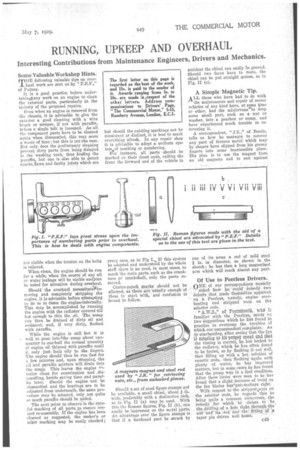RUNNING, UPKEEP AND OVERHAUL
Page 81

If you've noticed an error in this article please click here to report it so we can fix it.
Interesting Contributions from Maintenance Engineers, Drivers and Mechanics.
Some Valuable Workshop Hints.
MHE following valuable tips on over1 haul work are sent us by " P.E.F.," of Putney.
It is a good praetice before undertaking:1mq work on an engine to clean the external parts, particularly in the vicinity of the proposed repairs.
Even when an engine is removed from the chassis, it is advisable to give the exterior a good cleaning with a wire brush or scraper, if not with paraffin, before a single bait is loosened. As all the component parts have to be cleaned again when dismantled, this may 0,,e111 a waste of time; but this is not the case. Not only does the preliminary cleaning prevent dirty parts from being duinped in the washing tank, thus fouling the paraffin, but one is also able to detect cracks, flaws and faulty joints which are
not visible when the tension on the bolts is relieved.
When clean, the engine should be rim for a while, when the source of any oil or water leakage will be visible andlea.n be noted for attention during overhaul.
Should the overhaul necessitate-Witmoving and completely stripping the engine, it is 'advisable before attempting to do so to clean the engineointernally. This may be accomplished by running the engine with the radiator covered till bat enough to thin the oil. The sump can then be drained of dirty. oil and sediment, and, if very dirty, flushed with paraffin.
While the engine is still thot it is well to pour into?the sump about one quarter to nne-half the normal quantity of engine oil thinned with paraffin until it only just feels Oily to the fingers. The engine should then be run fast for a few minutes and, upon stopping, the oil and paraffin mixture will drain into the •suinp. This lea-es the engine i"tenor clean for examination and dismantling, beside saving time and paraffiu later. Should the engine mot be dismantled and the bearings are to be adjusted from underneath, the same proeedure may be adapted, only not quite so much paraffin should be added.
The next point to.observ'e is the careful marking of all parts,to. ensure correct re-assembly. If the engine has been cleaned as suggested, the maker's or other marking may be easily checked ;
but should the existing markings not be consistent or distinct, it is best to mark everything afresh. In any repair shop it is advisable to adopt a uniform systemvof marking or numbering.
For instance, all parts should be marked on their front ends, calling the front the forward end of the vehicle in
every case, as in Fig 1.0If this system be adopted and understood by the whole staff there is no need, in most cases, to mark the main parts, such as the crankcase .or crankshaft, only the parts removed.
Centre-punch marks should -not be allowed, as 'there are-usually enough-of them to start with, and confusion is bound to follow.
Should a set of steel figure stamps not be available, a small chisel, about i fn. wide, preferably with a distinctive nick, as in h'ig. II (a) may be used. . With this the Roman figures, Fig. II (b), can easily be impressed on the nietal parts; An advantage over the figure stamps is that if a hardened part be struck by accident the chisel can easily he ground. Should two faces have to mate, the chisel can be put straight across, as in Fig. II (c).
A Simple Magnetic Tip.
ALL those who have had to do with
the maintenance and repair of motor vehicles of any kind have, at some time or other, had the misfortuneto drop some small part, such as a nut or washer, into a gearbox or cutup, and have experienced much trouble in recovering it.
A correspondent, "JR.," of Bootle, tells us how he manages to recover any part of ferrous metal which may by chance have slipped from his greasy fingers into some inaccessible place. His plan is to use the magnet from an old magneto and to rest against one of its arms a rod of mild steel in. in diameter, as shown in the sketch; he has then a long magnetized arm which will reach almost any part.
Of Use to Peerless Drivers. ONE, qf our correspondents recently asked bow he could remedy twa defects that made. theaaseltes apparent on a Peerless, namely, engineoverheating and stripped nuts ou the
selector rods. •
" PortS)ffoutli, tvhd3. familiar with the Feeders, sends na two suggestions which hehas found in practice to overcome the, troubles of which our correspondent complains.As -to overheating, after seeing that the Rut rotating at ails prpe ueeU gml tha: t the timing is correct, he has looked to the radiator, which he has often found to be fouled, so by flashing it out well. then filling up with a hot solution of caustie soda, then' flushing again with plenty -of water, he has improved matters, but 111 some cases he has found that the pump was in a foul con ditiou. After these items were -seen to he has found that a slight increase of twist on the fan blades haOputmatters right.
With respect ta the strippediuuts on the selector rods, he regards this as being quite a common oceurrenee, the remedy for which he claims to be the drilling-of a hole right through the' nut -ancrits .rod and the fitting of "a taper pin driven well home.






























































































































